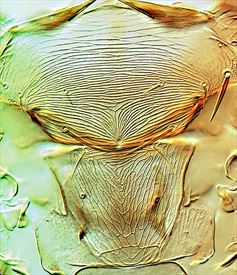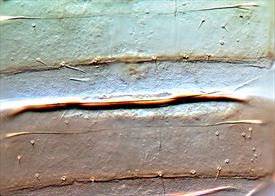Distinguishing features
Both sexes fully winged. Body and legs mainly brown, abdomen sometimes paler medially; antennal segment III with basal half sometimes yellow; fore wing fuscous, colourless in distal fifth and proximal quarter. Head slightly longer than wide, similar to that of Aeolothrips. Antennae 9-segmented; segments III and IV each with a narrow sensorium half as long as its segment and curving around apex, with internal discoidal markings. Pronotum similar to that of Aeolothrips, but 1 pair of posteroangular setae usually slightly stouter than the discal setae. Metanotum reticulate, the reticles with internal markings. Fore wings and abdomen similar to those of Aeolothrips in structure, but sternites with at least 2 pairs of discal setae laterally.
Male similar to female but abdomen slender, without terminal claspers or dorsal tubercles.
Related species
Only two species are placed in this genus, the second one being inauditus (Bianchi) from New Caledonia. However, courtesy of Masami Masumoto, an apparently related species has recently been seen from Japan. The genus Desmidothrips shares character states particularly with Desmothrips from Australia.
Biological data
Presumably predatory on small arthropods, collected from Hebe stricta flowers. Also extracted from native leaf litter and beaten from Muehlenbeckia, Coprosma, Leptospermum ericoides, and L. scoparium.
Distribution data
Known only from New Zealand (Three Kings Islands / ND, AK, CL, BP, GB, TO / NN, SD). Collected from August to February.
Family name
AEOLOTHRIPIDAE
Species name
Desmidothrips walkerae Mound
Original name and synonyms
Desmidothrips walkerae Mound, 1977: 151
References
Mound LA & Walker AK (1982) Terebrantia (Insecta: Thysanoptera). Fauna of New Zealand 1: 1–113.
Mound LA, Tree DC & Paris D (2012) OzThrips – Thysanoptera in Australia. http://www.ozthrips.org/




